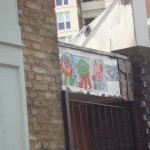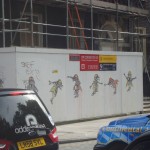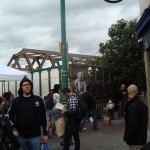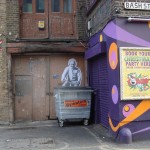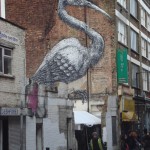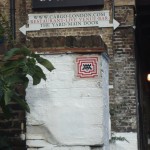Entries Tagged as '2010 ChristopherB'
September 21st, 2010 · 2 Comments
From the various services/presentations/synopses of religion we attended, it appeared that Christianity in London is dead. The two major Christian establishments we attended as a class, St. Paul’s Cathedral and Westminster Abbey (and technically, the abbey out in Stratford-upon-Avon, but that was quite a quick visit), did not appear to have any sort of religious community. Well, that’s not exactly a surprise – these locations are such tourist destinations it would be almost impossible to have services, or a regular church membership. However, this does not mean that Christianity is dead in London.
Yes, its true that a large majority of those who consider themselves Christians, or more specifically Anglicans, subscribe to a small amount of Christian beliefs. In this way, the reported statistics of adamant Christians are quite inflated, as noted in the readings. Well, Andrew and I decided to attend a Christian service this past Sunday, and it was really something.
First off, the service was held by Hillsong, the church’s name, in the Dominion theatre (the We Will Rock You one) and it was PACKED. I do not know the exact number of attendees, but it must’ve been over 500. The worship songs were also played by an at least 10 person band. 5 singers/get-the-churchgoers-pumped-up-by-dancing-around-and-starting-claps, 3 guitarists, a bass, a drummer, 2 keyboards, it was crazy. There was a lightshow during the songs, and the whole place was full of an amazing energy. This was somewhat like other mega-churches I had attended back in the States, and because of this, I was a bit worried about the overall tone of the service – whether it would actually stay focused on Christian teachings/values, whether it would be extremist. But it was actually quite normal. The band didn’t get caught up in the light show and reiterated why they were playing the music they were
The normal preacher introduced an energetic Australian as the guest speaker, and his sermon was on the prosperity gospel. Andrew and I both agreed that he was very well spoken, very entertaining, and the message he was describing was great. However, he was much funnier than many preachers I’ve seen in the States, and overall much more animated. I was literally laughing quite hard for some of the service (a bit awkward to do in Church normally) and really enjoyed his sermon on the whole.
Overall, it was a great experience. It was a very involving and exciting, which made a lot of sense as we further discussed it. Churches in England are, like all Churches, trying to attract more people, especially young people. They emphasized this in their explanation of how important community is to them, and had a video on different groups you could get involved with. This Church’s communities are everywhere; it was really quite impressive and cool. Perhaps this extra flair is added to the service to try and rouse faith in a generally lacking Christian body in London.
I doubt this service is representative of all Christian services in London; however, I found it encouraging and informative to see that Christian services do exist here outside of St. Paul’s and Westminster Abbey. All the people seemed really quite friendly, and they even shook our hands (take that Kate Fox!). Though I am not sure whether Hillsong has an information session like the Mandir or Mosque, it would certainly be interesting to investigate. It might be a bit hard for them to hold something similar, as they have no permanent building.
Last bit: I was fascinated by two other features of the service. One, the ethnic diversity of the people. We have learned that London is an incredible myriad of cultures, and this cultural mélange was really reflected in the audience. In my row alone, there was a Latino family, several Afro-Caribbeans, and an Asian woman, plus two white kids (me and Andrew). I thought it was really neat to see London’s diversity reflected in the church audience. I found this to be a bit different than the Mosque and Mandir, and I can’t say for the synagogue (saw very few people in there). Lastly, the Englishness of the service in some ways. There were a ton of cultural references that neither Andrew nor I understood, but everyone else found quite funny. It was like being on the outside of an inside joke, but we still laughed to not be awkward. Anyway, I don’t think this would happen as much in America. I think Americans are much less aware of their culture than to do this, but the Brits certainly aren’t.
Tags: 2010 ChristopherB · Churches and Cathedrals
September 21st, 2010 · No Comments
The parks of London provide a natural respite from the busy, hectic, and stressful atmosphere of the city. Once in them, you are enveloped by a green tranquil, unable to hear the bustle of cars and people outside the parks’ confines. I have personally experienced this phenomenon at several parks, ranging from Regent’s park (where I ran for the first time since surgery! not a bad debut location), Hyde Park, and most others. This type of division between hustle-bustle and repose mirrors the separation of work and play that Fox often talks about.
However, there is also a clear division within the park of activities that mirrors this division of social and work life. There are areas for sitting contemplatively in very silly chairs, which you are supposedly required to pay for. There are areas for looking at quite nice fountains, sculptures, or gardens. Then there are designated areas for sports, with soccer nets and rugby… posts? Tennis courts seem a bit necessary to be fenced off for convenience’s sake. Several little cafés are sprinkled throughout the parks as well.
Regent’s park matches the above description. I’ve made several trips to this park to run, play a bit of ultimate, have a cup of coffee, or just stroll around and look at the great horticulture. However, all of these activities would occur in different locations in the actual park. This segments the activities, and consequently divides the people that enjoy different forms of recreation. Personally, it made me very uneasy. If I were to throw a disc in the wrong area, I risked getting publicly reprimanded (as classmates have experienced). Anyway – it would take quite a bit of time for me to analyze this division (and I really don’t have the experience or expertise to do so) but there has to be some sociological effect. If you have thoughts on this, just comment on this post.
However, not all parks match this model. St. Jame’s park, home of many venereal diseases during the restoration period, per Dennis’ description, is seemingly built for nothing but comfort and relaxing. There are nice little walks along the lake, a couple bridges, some out-of-place fowl, and many large grassy areas upon which you can sit. However, in a couple walks through the park, I never saw anyone playing catch, football, or any other sport in these large areas. Though it was suspiciously absent of proper monuments (at least, I didn’t see many), the website is careful to highlight the pelican feeding from 2:30-3, and the deck-chairs. Weird. More leisure activities. I should note that there is a quite disproportionately small playground for children. However, as a whole, this is not a built-for-fun park. It is a built-for-relaxing-park, and I think is such because of its close proximity to Buckingham Palace. Green Park, also bordering Buckingham Palace, mirrors this model of relaxation, rather than recreational, with a few monuments (such as the Canada memorial), and is a bit more open green spaces rather than pathways-and-lakes. To me, these two parks are just not okay. I envision parks as a place where you can run around, play whatever kind of games you want. Having fancy gardens in parks just seems to counteract this.
Hyde park, the last park I will discuss in this post, blends athletics and relaxation much like Regent’s. And, just like Regent’s, different activities are segmented. There are different areas for sitting in lawn chairs, areas for tennis, I’ve seen people playing soccer on some of the larger fields (quite far away from the chairs, mind you), and the notorious Speaker’s Corner, completely ostracized from any central location. I suspect that its location is completely intentional whatever authority governs the parks wanted to make sure the… colorful characters that frequent the corner would not pollute (in their mind) the rest of the park.
Well, the parks are divided not only from the city but often divided within themselves. What effect this has on the psyche of park attendees, I’m not sure. Though I love the idea of having large parks in cities, I don’t like this division. If you want to have fancy gardens, just don’t call the whole thing a park.

 That these two photos (both personal) came from the same park (Regent’s) makes little sense to me (though the picture from the right, in my opinion, should not even come from a park).
That these two photos (both personal) came from the same park (Regent’s) makes little sense to me (though the picture from the right, in my opinion, should not even come from a park).
Tags: 2010 ChristopherB
September 20th, 2010 · 2 Comments
People have already expounded on many basic rules of pubs: go to the bar to order, know what you’re ordering before you get there, etc. For this rules section, I am going to talk a bit about the Court in particular, which many of us have frequented. There’s a snooker table upstairs (which is honestly just a pathetic imitation of billiards) that is of particular interest to me, as I love shooting pool in my basement and do so quite frequently. I noticed that people rarely went upstairs and simply took table, despite no one else playing – it would be rude to assume priority, as someone may have been thinking about starting a game and simply hasn’t gotten around to it. Only after a bit of time can one start a game. Then, once you start a game, you better get on with it. No silliness can occur, as others are now anxious to play as well. If you’re not good at snooker, then you can abbreviate your playing time by simply forfeiting the table to the next players (quite embarrassing) or by coming up with a discreet and fun way of knocking the balls in by some other means than the typical cue-to-cue-ball-to-other-ball method. We took quite a bit of time on our game, and were actually asked to speed it up. Fortunately there was no awkward overlap as one of the bouncers came upstairs to announce that everyone had to go downstairs.
I don’t particularly understand this everyone-to-the-first-floor rule. Why cram more people into the already-packed downstairs? The only explanation I can muster is that as the night goes on, people are increasingly drunk, and thus prone to act in exponentially dangerous manners. Another rule at the Court does involve ordering drinks, as they sell pitchers of ale, rather than just pints/half pints. To order 4 pints, rather than a pitcher of ale, will warrant you a scoff, from the bartenders and from eager-to-order onlookers. I suppose this is simply due to the increased efficiency of ordering pitchers, and by violating this principle you are delaying other drinks being poured. I also noticed that, at the court, public singing is completely fine, in fact, encouraged. For instance: about a week ago it was some patron’s birthday. Though there were about 8 or so others there clearly to celebrate with her, quite a few (as in, about 30 other people) more joined the chorus for her “happy birthday” song. Another example: R. Kelly’s remix ignition came on (once due to an unknown contributor, and once because of me), which is quite a popular song. I would say about half the pub was singing the chorus, with varying volume levels. This phenomenon occurred with most uber-popular songs. I think this public singing was acceptable and prevalent thanks to the younger crowd the Court… courts.
This type of public singing would NEVER occur at my favorite pub thus far, the George on Fleet st. The George is an older pub (has been around since the late 18th century) and attracts an older, and more reserved crowd. Obviously, their ale selection is great and changes from week to week, though my favorite so far has been a stout called Murphy’s. It’s older and darker interior encourages quiet conversation, which isn’t contaminated by any music. It’s also a lot less crowded than the Court. You don’t have to plow your way through to the bar, and then wait five minutes while desperately trying to capture a bartender. The bartenders are thus more relaxed, and though not necessarily friendly, they aren’t unfriendly either. There are fewer distractions at the George as well – no snooker, and only one plasma TV hanging up in a bit of obscure place, rather than the Court that has multiple TVs on every wall. Instead, there are occasional paintings on the wall. I like this, as it reinforces why we ought to go to pubs: to socialize, to interact with others in a great setting. The only thing I don’t like about the George is that I haven’t been to the mysterious second floor. I also seem to remember there being lanterns inside, but that might be unmitigated optimism. I will check when I go back tonight for one last hoorah.
Overall, it’s a great pub, and one that I will miss when we head out to Norwich in a couple of days. In the most central point I agree with Orwell’s interpretation of what makes a good pub – a nice and quiet inside. Oh, and good beer. Unfortunately there is no garden, but the elusive second floor and flowerboxes out front suffice.
 above: the george, in all its glory. personal photo
above: the george, in all its glory. personal photo
Tags: 2010 ChristopherB · Pubs
September 19th, 2010 · 3 Comments

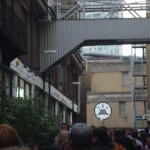
British street art is British for many reasons. First of all, it is rather egalitarian. Anyone can go up to a wall, etc. and post something. Street art also provides a sense of camaraderie and bonding the Brits so desperately desire, demonstrated in the mass art movements (in this post, the space invaders (p.s. there’s one right outside of Arran!) and einsteins-on-bikes). Though one may say that street art is generally anonymous and therefore no one gets a real sense of friendship – well, that demonstrates their social dis-ease. A sense of camaraderie without social interaction? British social utopia. These mass movements also embody the idea of fair-play, as anyone with a couple tiles (for space invaders) and anyone who can call Fatheads (large adhesive poster company, for Einstein) can contribute to these city-wide projects.
Other ways in which British street art demonstrates the conclusion section of Kate Fox’s book (and the main indicators of British social interaction and sociological thinking) are the ideas of moderation, modesty, and courtesy:
Moderation – Yes, street art in the simplest sense violates moderation. However, compared to American street art, it is very much so. A lot of American street art is gang signs, or is much more graphic (in general) than say… little weird monsters, pacman characters, or a large prelican-y looking thing. Even the famous banksy highly disguises political messages by reducing potentially graphic scenes into less explicit ones (but, at the same time, makes them all the more powerful!): http://blog.collectables-now.com/2008/01/12/bank-on-banksy/
Modesty – most British street art remains anonymous. Though there are exceptions to every rule, much of the art is left unsigned. No one still knows who Banksy, arguably the most famous street artist of all time, actually is. Looking above – clearly the squirrel and bird/pelican are of the same artist, and require a bit of skill. Neither has a signature.
Courtesy – my favorite, and in my opinion the most distinctive, aspect of British street art. A large amount of British street art is on non-permanent structures, like construction panels (see above pictures), or is either sprayed on newspapers which are then posted on walls, or are somehow non-permanent (like the einsteins, or the old woman).
Well, British street art is two things: awesome, and really British. Let me know if you find any that you think is neat, and let me hear your thoughts on whether you think it is British.
Tags: 2010 ChristopherB
September 18th, 2010 · 1 Comment
Many blogs and class discussions have centered upon the use (and in some opinions, misuse) of public funds for the museums. No funds have been squandered quite as much as those used for the Sir John Soane museum. Outside the building there is a plaque proudly proclaiming that over 6 million pounds had been raised, primarily via the national lottery, to restore the illustrious home of the architect Sloan, most famous for designing the London Bank (I only found this out because it was one a small plaque inside).

taken from http://blog.londonconnection.com/?p=2799
Honestly, the museum is a huge waste of money. It is like colonial Williamsburg in the sense that it’s a preservation of an older house from a past time, except that it’s completely misrepresentative of early 19th century architecture because it’s too well-designed. Soane’s house is architecturally impressive – many roofs feature intricate designs and the different rooms have many different magnificent qualities. However, there is nothing explaining the various architectural concepts (at least that are clear enough to museum-goers, or just me). There are only few plaques explaining, or even defining, pieces of art or sculptures, which are arranged in hodge-podge and haphazard fashion. Yes, the architecture is impressive. However, it is truly ridiculous to spend 6 million pounds, of public money, to preserve and restore a bit of tiny, though spectacular architecture.
The British Museum, though certainly more expensive, is far more educative than the Soane museum. It not only contains incredible items from world history – it organizes and explains them, giving them far greater meaning then random objects that look cool (or don’t). Because it serves a purpose, it is worth the public money required to fashion such an institution.
Clearly, the Soane Museum best exemplifies the reverse robin-hood syndrome (stealing from the poor, giving to the rich, a common criticism of the publicly-funded museums) because it’s so obscure and not educative that it really serves no purpose to the poor but does cater to rich architecture fanatics and people who already know enough about artifacts and art that they don’t necessarily need plaques explaining them.
There are simply too many better uses for 6 million pounds, the public sponsorship of the Soane museum is, in my opinion, un-sound. What do I make of this then? I think the preservation and sponsorship of the Soane museum highlights England’s obsession with its past, and more specifically, a superficial past. Just as the Imperial war museum champions Britain’s involvement in WW II and skirts over that whole Africa colonialism bit, the Soane museum makes late 19th and early 20th century Britain look classy, as this is a model house from that time. It also simply echoes what we’ve seen before: Britain loves its past, and making it look good.
Tags: 2010 ChristopherB · Museums
September 14th, 2010 · 1 Comment
While watching 39 Steps, I was particularly struck by the British quality the play. I should first say that I thought that the play was brilliant. It was funny, inviting, featured brilliant directing and acting, and was unlike I had anything I had seen in theatre before.
It was innovative in many ways (at least, to me). The use of intentional mistake, such as the delayed ringing of the telephone, the late entry of the professor, the female hostess having to kick the fireplace to make it roar, etc. endears the viewer to the play, and the cast. With a cast of four, the audience was obviously aware that different characters were played by the same actors – a risky, but in the end, incredibly successful strategy. The talent required and involved in pulling off such a play with only 4 actors made it a hilarious experience, especially when an actor had to play multiple characters in the same scene. Many of the chase scenes, or most of the danger, such as when Hannay is dodging the airplanes, or climbing across bridges, and so on and so forth, always looked silly. The death of the professor, the absurd throwing of the body on to the stage renders a potentially dramatic and tragic scene hilarious. All of the above examples demonstrate the “importance of not being earnest” rule that Fox emphasizes in her text (62). I particularly enjoyed the use of multiple hats, or two sided costumes, which can call into question the legitimacy of character and identity in drama. This risk taking, in my opinion, was really reflective of what Rick was talking about: the greater freedom West-End theatre/directors have, and how it can be used to produce a much more fun play to watch.
The play also featured many staple aspects of British sociological culture, prescribed by Fox in Watching the English. Understatement (see pg. 66) made its most obvious appearance right before intermission: Hannay is shot in the chest, the audience thinks him dead, and his only response: “Booga.” As previously seen in The Merry Wives of Windsor, the poor Scots are again mocked for their accent (which is quite exaggerated, as is the German accent?), reinforcing the British obsession for their own particular accent, as speech is considered “all important” (82). As much of our class has noticed, the overuse of “sorry” in the English lexicon is satirized (following the importance of not being earnest, and the love of hypocrisy) in most notably, the train scene as passengers infinitely apologize. Other staple phrases in the play include “carry on” and “stay calm,” a not-so-distant relative of the ubiquitous “keep calm and carry on.”
Other particularly English qualities of the play include the speech that Hannay is thrust into. With nothing to draw on except creativity, he resorts to a favorite idea of the British: fair play (407). This uniting idea draws applause from the crowd and he pulls it off. Politeness’ importance (407) is also emphasized in the play, where after the fight in the bog, Hannay sincerely says “bless you” to the opponent’s sneeze. The potentially sexy but instead amusingly awkward hotel room scene is reflective not only of how uncomfortable the British are with sex but also the men failing as flirts (327, 328). Though Hannay is handsome with his “brown, wavy hair,” he can’t seal the deal (at least until later).
Well, 39 Steps is clearly influenced by British culture. However, two token aspects of British culture I felt were missing: class and imperialism. Imperialism makes a small appearance right at the beginning, but then is absent, as is class. Perhaps these two issues (specifically Imperialism) would make the play too serious. Or, they could satirize it (again, imperialism), typical of British culture.
Do you think it’d be inappropriate to satirize such a serious breach of human rights, specifically in a comedic manner?
Tags: 2010 ChristopherB · Theatre
September 9th, 2010 · 4 Comments
In her social analysis Watching the English, Kate Fox explains that, to the English, their car is their own private space, insulated from the entire world (169). The English also seek to “maintain as much privacy as possible, by pretending that… [others] do not exist” on the tube, bus, and other systems of transportation (139). Similarly, the strategic placing of a phone on a nearby table/counter in a pub can act as a social guard that makes an impenetrable magical barrier, protecting the user. Lastly, if the user holds the phone, they often feel connected to friends stored in the address book, reassuring them that they aren’t alone (86). I have noticed all these things in different locations, and I consider them all symptomatic of the “social dis-ease” that Fox discusses in her book. However, I have noticed similar results in many different other areas as well, in general and specifically on a long walk I took to try and find some famous street art.
Take, for instance, the incessant displays of public affection. People “snog” on the escalator going down to the subway, sitting at booths in pubs, at stoplights on scooters, on the street corner, on the tube, everywhere. There are also a superfluous amount of twenty-something couples holding hands, in a variety of social settings. Couples walking at five o’clock in suits and formal dresses hold hands. Couples drinking in pubs hold hands at or under the table. Holding hands, though in America generally limited to teens, is standard protocol for much older couples.
There are also an incredible amount of these young adults (23ish-35ish) waiting at tube stops for their significant others. Literally, people line the walls surrounding the stairs leading down to the tube. It’s amazing. They are so committed to their other (or at least want to appear so, or are afraid to ride the tube by themselves) that they are willing to sit there and wait, for a decent amount of time, for their significant other. Perhaps I’m just heartless, but I think this is silly. These are examples of two phenomenon mentioned in the first paragraph: both isolating oneself, as couples create mini-worlds in which only they exist (and make out), and a constant thirst for human connection, reinforcing that one matters/one is cared for.
This miniaturizing and need for affection is, in my opinion, because the rest of the culture is essentially cold. Walking down the street, I tried to look at people and give them friendly (yet not creepy) looks to see if they would be returned. I received a few quizzical looks, but people mostly either looked the complete opposite direction of me, or down at their shoes. Also, practically whenever we walk into pubs, we are either greeted by ominous stares or silence. Yes, this could just be because we’re Americans, but I’ve also noticed that when other Brits walk into pubs, they aren’t often greeted by bartenders or other patrons with smiles. When you drink at a pub, you do not mingle with other customers – you are there with your friends, and you stay within this microsphere. Talk too loudly on the tube, and you will be shunned, shushed, or yelled at. There are countless other examples of this similar type of behavior. No, Brits are not friendly people.
All of this makes me miss America in a small way. If you smile at someone on the street, they will usually smile back at you. Saying “hello” to a stranger will usually be reciprocated (and you won’t be considered a crazy person). Because of this social warmth, people do not feel the need to make out all the time in public spaces, reinforcing that they are together, that they are not isolated. The actual acknowledgement of others’ existence would also render excessive snogging a bit awkward. Twenty-five year old couples don’t hold hands nearly as often, because they don’t need to. American society is more open, and coordinately, people act less insecurely. Our expressions of love are privatized, as our society is, as a whole, more open.
Tags: 2010 ChristopherB
September 6th, 2010 · 1 Comment
John Elliot Burns, whose portrait was painted by John Collier, was a labor leader in the late 19th and early 20th century. He was also the first member of the working class to be elected to a cabinet.

photo courtesy of NPG website
In the piece, Burns has his hands on his hips and a somewhat contemplative yet subtly stern expression. To me, the hands-on-hips symbolizes his discontentment with the conditions for the working class of London, those whom he led as a labor leader. This is a classic position of humans to show malaise. The angle of his head and raised eyebrows seem to suggest a bit of a “what of it” attitude. To some degree, these features balance his bodily position. If he were to have a furrowed brow and straightened head, he may appear too antagonistic to those he was trying to persuade (members of parliament, etc.). The profound facial features reinforce his strength of character, with defined cheek bones and dark eyes, beard, hair, and eyebrows. His beard also makes him look older and more experienced in life.
Lastly, the relatively simple suit, shirt, and tie combination shows that he is not a man of superfluous extravagance. This simple attire reflects the plain dark brown background. As opposed to many of the other portraits in the galleries, where many posed in front of extravagant rooms, by the lake, or the countryside. Burns was not one for such extravagance, or at least he was not portrayed in this portrait as such. This again helps reinforce the idea that he was a man working for increased rights for laborers, a man of the people.
Overall, I think this is a great portrait that casts Burns as a strong man working for workers’ and laborers’ rights.
As to who was and was not in the gallery, as everyone else has concluded: it is primarily rich white people. To me, this makes quite a bit of sense. For the vast majority of British history, older affluent white people have been in power, subjugating the rest of everyone else. I find it highly unlikely that any of these aforementioned people thought “wow, I should really get a portrait painted of my lowly dockworkers, that would be a great piece for that national portrait gallery one day.” In no way do I endorse the absence of a wider variety of people. Though getting later into British history, i.e. after the mid 19th century when there has been less rampant subjugation, yes, there should have been more portraits included of other races/economic classes.
However I’m not quite sure who to blame for this. I believe (I may be wrong) that the vast majority of the portraits were done privately and then donated to the museum. These portraits are probably quite expensive to have painted, and thus most could not afford them for quite some time. Perhaps certain groups of people simply choose not to have their portraits done, even if it has become lately feasible for them. I feel like portraiture has certainly become less popular over the past century, which may explain the absence of the groups of people who have lately gained rights/power/money/etc. recently. Though I find it unlikely, another possible explanation is that perhaps the curators have many portraits featuring minorities and simply choose not to display them. I certainly hope that is not the case.
Tags: 2010 ChristopherB
September 3rd, 2010 · 3 Comments
I grew up attending orchestral concerts. My mom is a musician/music professor/teacher, and my sister is the same. So are 2 of my grandparents. My mom and dad met because of music. As a result, I’ve gone to more concerts, willingly and unwillingly, than I can count. I was quite excited to attend the BBC Proms series at the Royal Albert Hall. The performance featured the Czech Philharmonic playing a bit of Dvoråk and Janacek, and highlighted pianist Sir John Eliot Garder on the Grieg. Oh yes, and there were a couple encore pieces… what?
The Philharmonic and Gardner both played extra pieces, not listed on the program. After their wonderful display, and in response to raucous, and deserved applause, both Gardner and the orchestra played encores. The addition of pieces to a concerts’ repertoire is a foreign idea to American symphonies and formal concerts, where I’ve experienced a much stricter and reserved atmosphere. However the encore pieces were not the only differences between the Proms and American symphonic concerts.
Another major difference were the surprise coughing fits that infected the crowd in between movements of the symphonies/concertos. During these breaks at American concerts, the crowd is silent, waiting for the next movement to begin. while they contemplate the last bit, or potentially chuckle at another onlooker who is a concert rookie and actually clapped, a symphonic gaffe. However the Brits seem to either hold in all their coughs (and there are quite a few) or they are trying to subtly acknowledge that yes, that was quite good, please continue and keep up the good work! There is apparently a growing movement to actually clap between the movements, which can be read about further here and here. Perhaps the coughing was in fact an anti-clapping movement, as those with sudden bouts of whooping cough, bronchitis, or emphysema sought to defeat the class-less onlookers. Anyway, this whole thing puzzles me, but it is certainly not mirrored in American concerts.
Other disparities between the two cultures’ concerts include the “heave…ho” chant howled by onlookers as the stage crew moved the piano, the baseball-game-esque servers with iced buckets of beer parading the lower levels during intermission, the area for standing-crowd-only right in front of the stage, the incredibly animated movements of both the conductor, soloist, and orchestral members, and the heavy drinking of many concert-goers evidenced by the presence of flasks, beers, martinis, etc.
All of the aforementioned differences provided for a much more relaxed atmosphere, which made the concert ultimately more enjoyable. This phenomenon explains the last, and in my opinion awesome, difference: the overall number of attendees, but specifically the amount of younger members of the audience, was much higher than I have seen at American concerts (of symphonies and other variants of classical music). In short, the place was packed, and there a fair amount of young concert-goers, not all of which were with their parents. This increase in younger generations attending the concert is also reflected in the museums, portrait galleries, and theatre shows we’ve attended.
I can think of several reasons for this. First, the museums/shows/concerts in London are either free, or are still much cheaper than their American counterparts. Young adults are infamously cash-strung, and the steeper prices of admission to American centers of cosmopolitanism, intellectualism, etc. (including college) may deter attendance. Secondly, London’s examples of these cultural experiences are much more enjoyable. Most museums feature fun, creative and interactive displays/games/things-that-help-you-learn. Though for the concert these features were more subtle, like the exaggerated movements and poses of Gardner (frequently resembling Michael Jackson in Thriller) or the incessant coughing (at least, I did/would have enjoyed this time-to-make-noise period), they certainly made the experience more entertaining. Lastly, the relaxed atmosphere makes it more acceptable for younger people to attend these concerts/museums/etc. The museums and specifically the concert, are clearly not only for stuffy upper-echelons of society and rich old folks, but for all interested citizens.
The concerts, and theaters, museums, etc. draw young people to them. I would like to see America follow suit.
Tags: 2010 ChristopherB
Whitechapel Market was in some ways exactly what we expected: predominantly Muslim and Hindu. There were Halal butchers, veils, saris and curry vendors on every corner. Most shoppers had tan complexions and wore Islamic or Hindu clothing; however, there were also white, black, and East-Asian shoppers. There were some ways in which Salaam, Brick Lane and our other readings about immigration to the East End didn’t prepare us, though: we saw a handful of authentic-looking English pubs when we expecting corner-to-corner curry joints; when we had anticipated a rowdy, bustling circus, the market seemed so empty that at first we weren’t sure we were in the right place. We walked up and down Whitechapel Road looking for a more likely candidate, resembling the market of Hall’s Chalky and Mr. Ali. We eventually realized we were in the right place, but since this is the holy month of Ramadan, the market is a little more subdued than usual. We also noticed the stall-keepers were almost entirely male, and that many of the mannequins had pale skin and light hair. Among our favorite experiences: meeting a lifelong Londoner on a park bench and learning about the “decline” of the East End; being continually surprised by the various cultural characteristics and quirks of the East End population; and arguing about headscarves and religious tradition on a Bethnal Green picnic table. Hope you enjoy our pictures of the Whitechapel Market and the surrounding area – we really enjoyed our experience there, and we can’t wait to go back and see it after Ramadan.
Here are some links we thought you might like to check out:
This one claims to be the definitive website on Ronnie and Reggie Kray. You may remember these two gangsters from Salaam, and sure enough, when we asked our elderly informant about what he considers to be the “real” East End, the Krays were the first thing he mentioned. If you’re looking for a better idea of what the East End used to be like (and what some residents wish the East End still was like), take a look here.
See an informational website regarding Ramadan here.
The Royal London Hospital is located on the other side of Whitechapel road. There is a link here for more information about the hospital.
[kml_flashembed movie="http://www.youtube.com/v/JMvSb8bVRQQ" width="425" height="350" wmode="transparent" /]
The video on YouTube
Tags: 2010 Amy · 2010 ChristopherB · 2010 MaryKate · Markets · Pubs · readings






